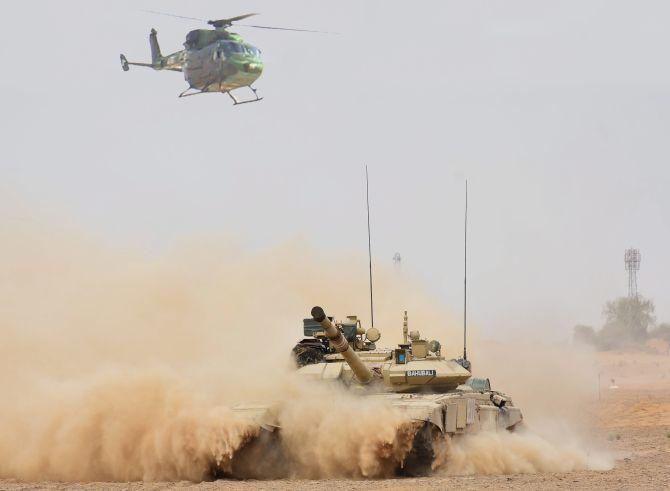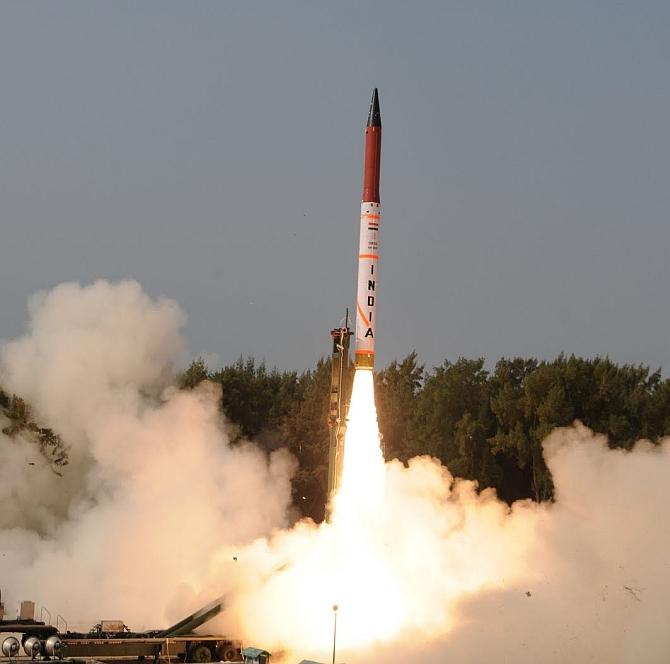'Offensive operations to capture objectives across the LoC to eliminate terrorist launch pads and deny the use of the most dangerous routes of infiltration, are likely to be limited to brigade-level attacks.'
'These limited operations are unlikely to escalate to war across the international boundary,' says Brigadier Gurmeet Kanwal (retd).

Now that the war clouds which had appeared on the horizon in the aftermath of the Pulwama suicide attack appear to be drifting away, it is necessary to carry out an assessment of the dangers inherent if a similar crisis occurs in future.
Clearly, Pakistan's deep state (the army and ISI) will not give up its employment of terrorism as an instrument of State policy and India has begun to carry the fightback onto Pakistan-controlled territory.
The primary source of danger ahead is the fact that India and Pakistan are both nuclear-armed with a long-standing territorial dispute over Kashmir and an active LoC.
Then United States President Bill Clinton had called Kashmir a 'nuclear flashpoint'. In the mid-1990s, Dr Ashley Tellis, a senior scholar at the Carnegie Endowment for International Peace, Washington (then with the RAND Corporation), had used the term 'ugly stability' to describe the strategic environment in South Asia.
When the war bugles begin to sound in South Asia, the world fears that it will once again witness the spectre of mushroom fireballs lighting up the sky and radiation clouds polluting large swathes of land.
Are these fears well founded, or can escalation of conflict to the level of nuclear exchanges be controlled?
For three decades since 1989-1990, Pakistan has been waging a proxy war to 'bleed India through a thousand cuts'.
Pakistan's deep state employs the military-jihadi complex comprising State-sponsored mujahideen of the LeT, JeM and HM (originally of Kashmiri origin) to launch terrorist strikes against sensitive targets in Kashmir and urban centres in India, often through suicide bombers.
Other weapons of choice in this asymmetric conflict include support to several home-grown militant outfits like the Naxals, creating a Hindu-Muslim divide through information operations and social media and economic destabilisation through measures like the circulation of fake Indian currency.
The stated aim of the deep state is to wrest Kashmir from India and finish what Pakistan calls the 'unfinished agenda of Partition'.
In the interest of avoiding large-scale conflict to give its people and economy an unfeterred opportunity to grow, India has shown strategic restraint and unbounded patience with Pakistan's shenanigans.
India opted to confine its counter-insurgency and counter-terrorism fightback to its own territory. It has been clear for some time that this strategy has failed to impose sufficient costs on the deep state.
At least twice in the past India and Pakistan had come close to war -- when Parliament was attacked by JeM operatives on December 13, 2001 and multiple strikes were launched by the LeT's sea-borne terrorists in Mumbai between November 26 and 29, 2008.
The latest round in Pakistan's game of brinkmanship has been the suicide bombing attack on a CRPF convoy in Pulwama by the JeM. Before that, armed forces bases at Pathankot and Uri had been struck.
Public opinion is India had been inflamed by the attack at Pulwama and Prime Minister Narendra Damodardas Modi had said that full freedom has been given to the armed forces to retaliate appropriately.
Imran Khan, the prime minister of Pakistan, denied any involvement and General Qamar Javed Bajwa, its army chief, warned India against any kind of retaliation.
India's response came in the shape of trans-LoC air strikes with precision-guided munitions (PGMs) on terrorist training camps.
India claimed that substantial damage had been inflicted on non-military targets and the battle lines once again appeared to be drawn.
Pakistan retaliated with air strikes, both sides lost an aircraft each and, after an Indian braveheart pilot who had ejected was returned two days, the crisis blew over.
How will India handle the next major attack emanating from Pakistani soil?
While India may be definitely expected to respond to the attack, the retaliation is likely to be limited to areas across the LoC in Pakistan occupied Kashmir and Gilgit-Baltistan.
Operations will in all likelihood once again include air-to-ground strikes with PGMs against terrorist training camps and critical infrastructure across the LoC from stand-off ranges on own side of the LoC.
Artillery bombardment of Pakistani army posts, battalion, brigade and division HQ, communications centres, ammunition and FOL dumps, key bridges, terrorist infrastructure and forward helipads may also be expected.
These will be supplemented by Special Forces operations and trans-LoC forays by infantry border action team (BAT).
Offensive operations to capture objectives across the LoC to eliminate terrorist launch pads and deny the use of the most dangerous routes of infiltration, are likely to be limited to brigade-level attacks.
These limited operations are unlikely to escalate to war across the international boundary. Division and higher-level offensive operations and fighter aircraft crossing the LoC to attack targets in depth run the risk of escalation.
Public opinion will be assuaged by a proportionate response sustained over a few days that inflicts visible punishment on the Pakistan army, terrorist launch pads and infrastructure.
However, escalation is a product of the political guidance given to the armed forces, intelligence assessments, the options open and the means available to the adversary and his senior commander's personality and much will depend on the response of the Pakistan army and air force.
During the Kargil conflict, India opted to limit its operations to throw out the Pakistani intruders to its own side of the LoC, as directed by then prime minister Atal Bihari Vajpayee. The Pakistan army had avoided escalating the conflict.
The Pakistan air force stayed out of the fighting altogether as, in any case, it has few viable options to retaliate in Kashmir.
If the Pakistan air force responds to the IAF strikes across the LoC by choosing to hit targets across the international boundary, or, if the Pakistan army crosses the international boundary anywhere into Indian territory, similar Indian retaliation is guaranteed.
Retaliatory military operations by India across the international boundary are likely to comprise deep offensive strikes at the level of Strike Corps operations or operations conforming to the Cold Start doctrine -- large number of shallow strikes by division-sized integrated battle groups (IGB) into West Punjab and Sind.
These will be accompanied by IAF and attack helicopter strikes across the international boundary on the Pakistan army's strategic reserves, Pakistan air force's airfields, missile launchers, HQ, communications centres, logistics infrastructure and terrorist training centres.
Naval operations may be launched against the Pakistan navy.
The aim of military operations across the international boundary will be to inflict maximum possible damage on Pakistan's military machine through the employment of massive firepower (artillery, missile, air-to-ground, naval).

Large-scale conventional conflict undoubtedly carries the risk of escalation to nuclear exchanges if Pakistan's nuclear redlines are crossed. Pakistan will not lightly opt for nuclear first use as India is likely to retaliate in accordance with its declared nuclear doctrine, which is massive retaliation.
Such retaliation will finish Pakistan as a functional nation State and the Pakistani generals are smart enough to understand this certainty.
Hence, if Pakistan finds itself in a hopeless situation on the battlefield -- a situation that the Indian armed forces will refrain from putting it in -- and chooses to escalate to nuclear levels, its response is likely to be graduated.
Pakistan may threaten the first use of nuclear weapons against Indian troops that have violated its space redline by penetrating deep inside.
This can happen in the fog of war due to wrong assessment of what the redlines are. A bolt-out-of-the-blue counter-force nuclear first strike on targets in the Indian heartland is most unlikely.
However, Pakistan would hope that the United Nations security council and the international community will intervene well before nuclear thresholds are reached.
And India will carefully calibrate both its initial retaliation and subsequent responses so as not to up the ante to large-scale conventional war-fighting, which would subsequently run the risk of nuclear exchanges.
Brigadier Gurmeet Kanwal (retd) is former Director, Centre for Land Warfare Studies (CLAWS), New Delhi.












 © 2025
© 2025